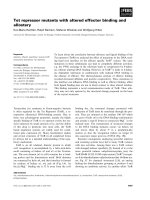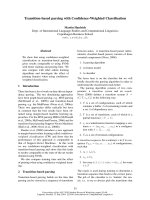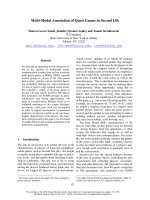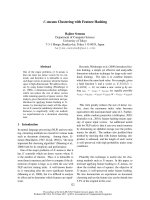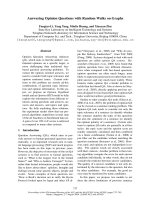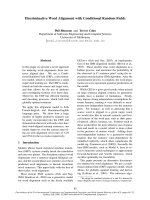Báo cáo khoa học: "Automating Temporal Annotation with TARSQI" ppt
Bạn đang xem bản rút gọn của tài liệu. Xem và tải ngay bản đầy đủ của tài liệu tại đây (53.98 KB, 4 trang )
Proceedings of the ACL Interactive Poster and Demonstration Sessions,
pages 81–84, Ann Arbor, June 2005.
c
2005 Association for Computational Linguistics
Automating Temporal Annotation with TARSQI
Marc Verhagen
†
, Inderjeet Mani
‡
, Roser Sauri
†
,
Robert Knippen
†
, Seok Bae Jang
‡
, Jessica Littman
†
,
Anna Rumshisky
†
, John Phillips
‡
, James Pustejovsky
†
† Department of Computer Science, Brandeis University, Waltham, MA 02254, USA
{marc,roser,knippen,jlittman,arum,jamesp}@cs.brandeis.edu
‡ Computational Linguistics, Georgetown University, Washington DC, USA
{im5,sbj3,jbp24}@georgetown.edu
Abstract
We present an overview of TARSQI, a
modular system for automatic temporal
annotation that adds time expressions,
events and temporal relations to news
texts.
1 Introduction
The TARSQI Project (Temporal Awareness and
Reasoning Systems for Question Interpretation)
aims to enhance natural language question an-
swering systems so that temporally-based questions
about the events and entities in news articles can be
addressed appropriately. In order to answer those
questions we need to know the temporal ordering of
events in a text. Ideally, we would have a total order-
ing of all events in a text. That is, we want an event
like marched in ethnic Albanians marched Sunday
in downtown Istanbul to be not only temporally re-
lated to the nearby time expression Sunday but also
ordered with respect to all other events in the text.
We use TimeML (Pustejovsky et al., 2003; Saur
´
ı et
al., 2004) as an annotation language for temporal
markup. TimeML marks time expressions with the
TIMEX3 tag, events with the EVENT tag, and tempo-
ral links with the TLINK tag. In addition, syntactic
subordination of events, which often has temporal
implications, can be annotated with the SLINK tag.
A complete manual TimeML annotation is not
feasible due to the complexity of the task and the
sheer amount of news text that awaits processing.
The TARSQI system can be used stand-alone
or as a means to alleviate the tasks of human
annotators. Parts of it have been intergrated in
Tango, a graphical annotation environment for event
ordering (Verhagen and Knippen, Forthcoming).
The system is set up as a cascade of modules
that successively add more and more TimeML
annotation to a document. The input is assumed to
be part-of-speech tagged and chunked. The overall
system architecture is laid out in the diagram below.
Input Documents
GUTime
Evita
SlinketGUTenLINK
SputLink
TimeML Documents
In the following sections we describe the five
TARSQI modules that add TimeML markup to news
texts.
2 GUTime
The GUTime tagger, developed at Georgetown Uni-
versity, extends the capabilities of the TempEx tag-
ger (Mani and Wilson, 2000). TempEx, developed
81
at MITRE, is aimed at the ACE TIMEX2 standard
(timex2.mitre.org) for recognizing the extents and
normalized values of time expressions. TempEx
handles both absolute times (e.g., June 2, 2003) and
relative times (e.g., Thursday) by means of a num-
ber of tests on the local context. Lexical triggers like
today, yesterday, and tomorrow, when used in a spe-
cific sense, as well as words which indicate a posi-
tional offset, like next month, last year, this coming
Thursday are resolved based on computing direc-
tion and magnitude with respect to a reference time,
which is usually the document publication time.
GUTime extends TempEx to handle time ex-
pressions based on the TimeML TIMEX3 standard
(timeml.org), which allows a functional style of en-
coding offsets in time expressions. For example, last
week could be represented not only by the time value
but also by an expression that could be evaluated to
compute the value, namely, that it is the week pre-
ceding the week of the document date. GUTime also
handles a variety of ACE TIMEX2 expressions not
covered by TempEx, including durations, a variety
of temporal modifiers, and European date formats.
GUTime has been benchmarked on training data
from the Time Expression Recognition and Normal-
ization task (timex2.mitre.org/tern.html) at .85, .78,
and .82 F-measure for timex2, text, and val fields
respectively.
3 EVITA
Evita (Events in Text Analyzer) is an event recogni-
tion tool that performs two main tasks: robust event
identification and analysis of grammatical features,
such as tense and aspect. Event identification is
based on the notion of event as defined in TimeML.
Different strategies are used for identifying events
within the categories of verb, noun, and adjective.
Event identification of verbs is based on a lexi-
cal look-up, accompanied by a minimal contextual
parsing, in order to exclude weak stative predicates
such as be or have. Identifying events expressed by
nouns, on the other hand, involves a disambigua-
tion phase in addition to lexical lookup. Machine
learning techniques are used to determine when an
ambiguous noun is used with an event sense. Fi-
nally, identifying adjectival events takes the conser-
vative approach of tagging as events only those ad-
jectives that have been lexically pre-selected from
TimeBank
1
, whenever they appear as the head of a
predicative complement. For each element identi-
fied as denoting an event, a set of linguistic rules
is applied in order to obtain its temporally relevant
grammatical features, like tense and aspect. Evita
relies on preprocessed input with part-of-speech tags
and chunks. Current performance of Evita against
TimeBank is .75 precision, .87 recall, and .80 F-
measure. The low precision is mostly due to Evita’s
over-generation of generic events, which were not
annotated in TimeBank.
4 GUTenLINK
Georgetown’s GUTenLINK TLINK tagger uses
hand-developed syntactic and lexical rules. It han-
dles three different cases at present: (i) the event
is anchored without a signal to a time expression
within the same clause, (ii) the event is anchored
without a signal to the document date speech time
frame (as in the case of reporting verbs in news,
which are often at or offset slightly from the speech
time), and (iii) the event in a main clause is anchored
with a signal or tense/aspect cue to the event in the
main clause of the previous sentence. In case (iii), a
finite state transducer is used to infer the likely tem-
poral relation between the events based on TimeML
tense and aspect features of each event. For ex-
ample, a past tense non-stative verb followed by a
past perfect non-stative verb, with grammatical as-
pect maintained, suggests that the second event pre-
cedes the first.
GUTenLINK uses default rules for ordering
events; its handling of successive past tense non-
stative verbs in case (iii) will not correctly or-
der sequences like Max fell. John pushed him.
GUTenLINK is intended as one component in a
larger machine-learning based framework for order-
ing events. Another component which will be de-
veloped will leverage document-level inference, as
in the machine learning approach of (Mani et al.,
2003), which required annotation of a reference time
(Reichenbach, 1947; Kamp and Reyle, 1993) for the
event in each finite clause.
1
TimeBank is a 200-document news corpus manually anno-
tated with TimeML tags. It contains about 8000 events, 2100
time expressions, 5700 TLINKs and 2600 SLINKs. See (Day
et al., 2003) and www.timeml.org for more details.
82
An early version of GUTenLINK was scored at
.75 precision on 10 documents. More formal Pre-
cision and Recall scoring is underway, but it com-
pares favorably with an earlier approach developed
at Georgetown. That approach converted event-
event TLINKs from TimeBank 1.0 into feature vec-
tors where the TLINK relation type was used as the
class label (some classes were collapsed). A C5.0
decision rule learner trained on that data obtained an
accuracy of .54 F-measure, with the low score being
due mainly to data sparseness.
5 Slinket
Slinket (SLINK Events in Text) is an application
currently being developed. Its purpose is to automat-
ically introduce SLINKs, which in TimeML specify
subordinating relations between pairs of events, and
classify them into factive, counterfactive, evidential,
negative evidential, and modal, based on the modal
force of the subordinating event. Slinket requires
chunked input with events.
SLINKs are introduced by a well-delimited sub-
group of verbal and nominal predicates (such as re-
gret, say, promise and attempt), and in most cases
clearly signaled by the context of subordination.
Slinket thus relies on a combination of lexical and
syntactic knowledge. Lexical information is used to
pre-select events that may introduce SLINKs. Pred-
icate classes are taken from (Kiparsky and Kiparsky,
1970; Karttunen, 1971; Hooper, 1975) and subse-
quent elaborations of that work, as well as induced
from the TimeBank corpus. A syntactic module
is applied in order to properly identify the subor-
dinated event, if any. This module is built as a
cascade of shallow syntactic tasks such as clause
boundary recognition and subject and object tag-
ging. Such tasks are informed from both linguistic-
based knowledge (Papageorgiou, 1997; Leffa, 1998)
and corpora-induced rules (Sang and D
´
ej
´
ean, 2001);
they are currently being implemented as sequences
of finite-state transducers along the lines of (A
¨
ıt-
Mokhtar and Chanod, 1997). Evaluation results are
not yet available.
6 SputLink
SputLink is a temporal closure component that takes
known temporal relations in a text and derives new
implied relations from them, in effect making ex-
plicit what was implicit. A temporal closure compo-
nent helps to find those global links that are not nec-
essarily derived by other means. SputLink is based
on James Allen’s interval algebra (1983) and was in-
spired by (Setzer, 2001) and (Katz and Arosio, 2001)
who both added a closure component to an annota-
tion environment.
Allen reduces all events and time expressions to
intervals and identifies 13 basic relations between
the intervals. The temporal information in a doc-
ument is represented as a graph where events and
time expressions form the nodes and temporal re-
lations label the edges. The SputLink algorithm,
like Allen’s, is basically a constraint propagation al-
gorithm that uses a transitivity table to model the
compositional behavior of all pairs of relations. For
example, if A precedes B and B precedes C, then
we can compose the two relations and infer that A
precedes C. Allen allowed unlimited disjunctions of
temporal relations on the edges and he acknowl-
edged that inconsistency detection is not tractable
in his algebra. One of SputLink’s aims is to ensure
consistency, therefore it uses a restricted version of
Allen’s algebra proposed by (Vilain et al., 1990). In-
consistency detection is tractable in this restricted al-
gebra.
A SputLink evaluation on TimeBank showed that
SputLink more than quadrupled the amount of tem-
poral links in TimeBank, from 4200 to 17500.
Moreover, closure adds non-local links that were
systematically missed by the human annotators. Ex-
perimentation also showed that temporal closure al-
lows one to structure the annotation task in such
a way that it becomes possible to create a com-
plete annotation from local temporal links only. See
(Verhagen, 2004) for more details.
7 Conclusion and Future Work
The TARSQI system generates temporal informa-
tion in news texts. The five modules presented here
are held together by the TimeML annotation lan-
guage and add time expressions (GUTime), events
(Evita), subordination relations between events
(Slinket), local temporal relations between times and
events (GUTenLINK), and global temporal relations
between times and events (SputLink).
83
In the nearby future, we will experiment with
more strategies to extract temporal relations from
texts. One avenue is to exploit temporal regularities
in SLINKs, in effect using the output of Slinket as
a means to derive even more TLINKs. We are also
compiling more annotated data in order to provide
more training data for machine learning approaches
to TLINK extraction. SputLink currently uses only
qualitative temporal infomation, it will be extended
to use quantitative information, allowing it to reason
over durations.
References
Salah A
¨
ıt-Mokhtar and Jean-Pierre Chanod. 1997. Sub-
ject and Object Dependency Extraction Using Finite-
State Transducers. In Automatic Information Extrac-
tion and Building of Lexical Semantic Resources for
NLP Applications. ACL/EACL-97 Workshop Proceed-
ings, pages 71–77, Madrid, Spain. Association for
Computational Linguistics.
James Allen. 1983. Maintaining Knowledge about
Temporal Intervals. Communications of the ACM,
26(11):832–843.
David Day, Lisa Ferro, Robert Gaizauskas, Patrick
Hanks, Marcia Lazo, James Pustejovsky, Roser Saur
´
ı,
Andrew See, Andrea Setzer, and Beth Sundheim.
2003. The TimeBank Corpus. Corpus Linguistics.
Joan Hooper. 1975. On Assertive Predicates. In John
Kimball, editor, Syntax and Semantics, volume IV,
pages 91–124. Academic Press, New York.
Hans Kamp and Uwe Reyle, 1993. From Discourse to
Logic, chapter 5, Tense and Aspect, pages 483–546.
Kluwer Academic Publishers, Dordrecht, Netherlands.
Lauri Karttunen. 1971. Some Observations on Factivity.
In Papers in Linguistics, volume 4, pages 55–69.
Graham Katz and Fabrizio Arosio. 2001. The Anno-
tation of Temporal Information in Natural Language
Sentences. In Proceedings of ACL-EACL 2001, Work-
shop for Temporal and Spatial Information Process-
ing, pages 104–111, Toulouse, France. Association for
Computational Linguistics.
Paul Kiparsky and Carol Kiparsky. 1970. Fact. In
Manfred Bierwisch and Karl Erich Heidolph, editors,
Progress in Linguistics. A collection of Papers, pages
143–173. Mouton, Paris.
Vilson Leffa. 1998. Clause Processing in Complex Sen-
tences. In Proceedings of the First International Con-
ference on Language Resources and Evaluation, vol-
ume 1, pages 937–943, Granada, Spain. ELRA.
Inderjeet Mani and George Wilson. 2000. Processing
of News. In Proceedings of the 38th Annual Meet-
ing of the Association for Computational Linguistics
(ACL2000), pages 69–76.
Inderjeet Mani, Barry Schiffman, and Jianping Zhang.
2003. Inferring Temporal Ordering of Events in News.
Short Paper. In Proceedings of the Human Language
Technology Conference (HLT-NAACL’03).
Harris Papageorgiou. 1997. Clause Recognition in the
Framework of Allignment. In Ruslan Mitkov and
Nicolas Nicolov, editors, Recent Advances in Natural
Language Recognition. John Benjamins, Amsterdam,
The Netherlands.
James Pustejovsky, Jos
´
e Casta
˜
no, Robert Ingria, Roser
Saur
´
ı, Robert Gaizauskas, Andrea Setzer, and Graham
Katz. 2003. TimeML: Robust Specification of Event
and Temporal Expressions in Text. In IWCS-5 Fifth
International Workshop on Computational Semantics.
Hans Reichenbach. 1947. Elements of Symbolic Logic.
MacMillan, London.
Tjong Kim Sang and Erik Herve D
´
ej
´
ean. 2001. Introduc-
tion to the CoNLL-2001 Shared Task: Clause Identifi-
cation. In Proceedings of the Fifth Workshop on Com-
putational Language Learning (CoNLL-2001), pages
53–57, Toulouse, France. ACL.
Roser Saur
´
ı, Jessica Littman, Robert Knippen, Robert
Gaizauskas, Andrea Setzer, and James Puste-
jovsky. 2004. TimeML Annotation Guidelines.
.
Andrea Setzer. 2001. Temporal Information in Newswire
Articles: an Annotation Scheme and Corpus Study.
Ph.D. thesis, University of Sheffield, Sheffield, UK.
Marc Verhagen and Robert Knippen. Forthcoming.
TANGO: A Graphical Annotation Environment for
Ordering Relations. In James Pustejovsky and Robert
Gaizauskas, editors, Time and Event Recognition in
Natural Language. John Benjamin Publications.
Marc Verhagen. 2004. Times Between The Lines. Ph.D.
thesis, Brandeis University, Waltham, Massachusetts,
USA.
Marc Vilain, Henry Kautz, and Peter van Beek. 1990.
Constraint propagation algorithms: A revised report.
In D. S. Weld and J. de Kleer, editors, Qualitative Rea-
soning about Physical Systems, pages 373–381. Mor-
gan Kaufman, San Mateo, California.
84




